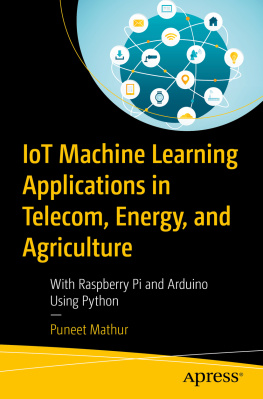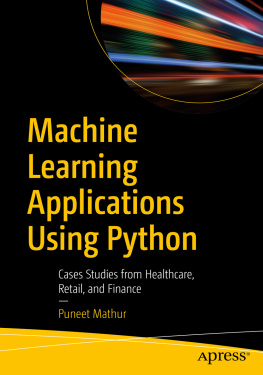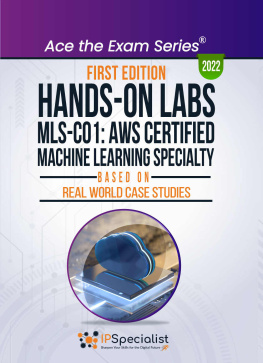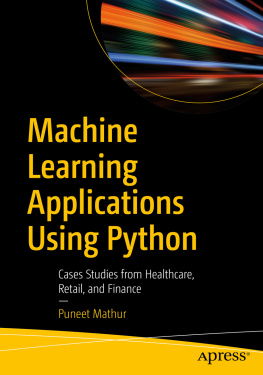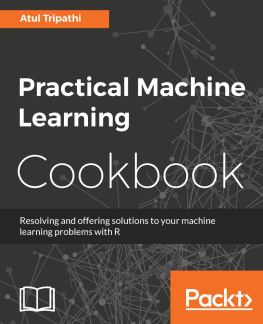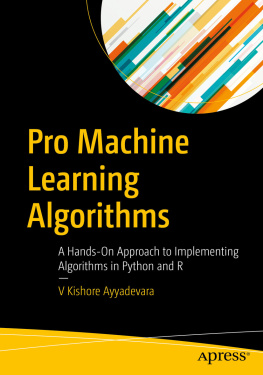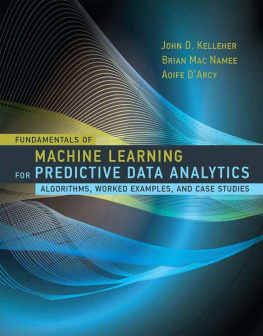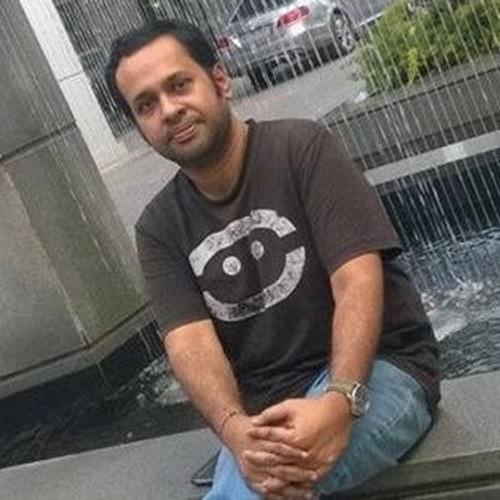Puneet Mathur
IoT Machine Learning Applications in Telecom, Energy, and Agriculture
With Raspberry Pi and Arduino Using Python
Puneet Mathur
Bangalore, Karnataka, India
Any source code or other supplementary material referenced by the author in this book is available to readers on GitHub via the books product page, located at www.apress.com/978-1-4842-5548-3 For more detailed information, please visit www.apress.com/source-code .
ISBN 978-1-4842-5548-3 e-ISBN 978-1-4842-5549-0
https://doi.org/10.1007/978-1-4842-5549-0
Puneet Mathur 2020
Apress Standard
The use of general descriptive names, registered names, trademarks, service marks, etc. in this publication does not imply, even in the absence of a specific statement, that such names are exempt from the relevant protective laws and regulations and therefore free for general use.
The publisher, the authors and the editors are safe to assume that the advice and information in this book are believed to be true and accurate at the date of publication. Neither the publisher nor the authors or the editors give a warranty, expressed or implied, with respect to the material contained herein or for any errors or omissions that may have been made. The publisher remains neutral with regard to jurisdictional claims in published maps and institutional affiliations.
Distributed to the book trade worldwide by Springer Science+Business Media New York, 233 Spring Street, 6th Floor, New York, NY 10013. Phone 1-800-SPRINGER, fax (201) 348-4505, e-mail orders-ny@springer-sbm.com, or visit www.springeronline.com. Apress Media, LLC is a California LLC and the sole member (owner) is Springer Science + Business Media Finance Inc (SSBM Finance Inc). SSBM Finance Inc is a Delaware corporation.
This book is dedicated to the Supreme Divine Mother.
Introduction
In late January of 2019, after attending a conference on IoT, I met a potential client in Mumbai regarding the use of machine learning in a factory setting. He wanted to know if machine learning could be used in his environment and, if so, what kind of business benefit could he look forward to in its implementation. I discussed a few use cases with him which involved the use of Industrial Internet of Things (IIoT). In business, there are two types of strategies: one is revenue growth and the other is cost reduction. If you are in a business where there is high revenue growth taking place, then you would not bother much about cost reduction. Your focus would be to expand your business. However, if you are seeing steady growth for a number of years and you have stiff competition, then the pressure on you is to not just to maintain your existing customers but also to reduce cost so that you can beat the competition. My client was in this mode of business. Most of the use cases I showed him were of revenue growth, which did not meet his expectation. However, the use case of doing an energy audit in his factory using IIoT caught his attention and he explained that he had a large electricity bill and he wanted me to implement an energy audit to help reduce cost. His next set of questions involved how much of cost reduction he could look forward to versus the investment that was needed to implement the solution. I gave him a small workout with a plan for its implementation, which was received well within his company, although we were doing this for the first time in a factory setting.
This book features one of those solutions, although not the complete one as it would need a separate book to do so. But the solutions in this book will help you get started in IoT and IIoT using machine learning.
Acknowledgments
I acknowledge the various engineers working at telecom companies, hi-tech agricultural farms, and in the energy sector who came forward to share information on how their operations needed further improvements and where AI could help; I used anonymous surveys conducted through personal and online means. I would also like to thank various company experts from multinationals like ABB, GE, and others who came forward to discuss topics related to this book, which needed their suggestions.
All the data in this book is anonymized and is not taken from any particular company, situation, or source. Any resemblance to actual data is only a coincidence. The datasets in this book are based on my experience working with clients and engineers; however, I have taken care to not take any such data from them and it is completely clean of any plagiarism.
The instruments and sensors including the drone and energy devices are not sponsored by any company nor did I get any fee or any incentive of any kind to use one over the other. The choice of all devices and sensors used in this book is entirely based on my independent judgement and experience.
Table of Contents
About the Author
Puneet Mathur
is an author, AI consultant, and speaker with over 20 years of corporate IT industry experience. He has risen from a programmer to a third-line manager working with multinationals like HP, IBM, and Dell at various levels. For several years he has been working as an AI consultant through his company, Boolbrite International, for clients around the globe, guiding and mentoring client teams stuck with AI and machine learning problems. He is a regular speaker at international conferences. He is also an Udemy Instructor with several courses on machine learning. His latest bestselling book,Machine Learning Applications Using Python(Apress), is for those machine learning professionals who want to advance their career by gaining experiential knowledge from an AI expert. His other hot books includeThe Predictive Project Manager,The Predictive Program Manager,Prediction Secrets, andGood Money Bad Money. You can read more about him on his website at www.PMAuthor.com .
About the Technical Reviewer
Abhishek Nandy
has a B.Tech in IT and is a constant learner. He is a Microsoft MVP for the Windows platform, an Intel Black Belt Developer, and an Intel Software Innovator; he has a keen interest in AI, IoT, and game development. He is currently serving as an application architect in an IT firm. He also consults on AI and IoT and does projects with AI, ML, and deep learning. He is also an AI trainer and drives the technical part of the Intel AI Student developer program at leading IITs in India. He has showcased a demo on Reinforcement Learning with Unity at SIGGRAPH 2018 in Vancouver, Canada. He has won four AI for PC Challenges at Intel. He was involved in the first Make in India initiative, where he was among the top 50 innovators and got trained in IIMA. He won an Early Innovation Game Dev grant from Intel; the game got published for Runs Great on Intel.
Link to DevMesh: https://devmesh.intel.com/users/abhishek-nandy

